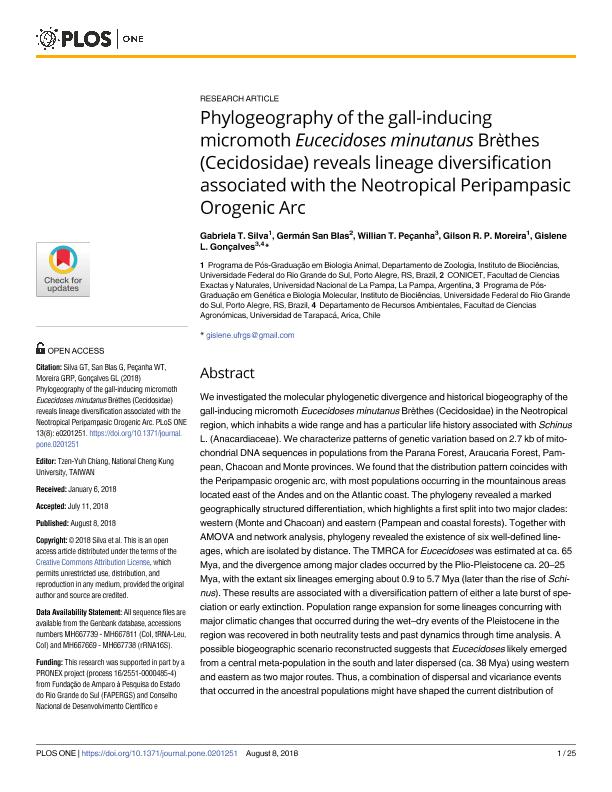Mostrar el registro sencillo del ítem
dc.contributor.author
Silva, Gabriela T.
dc.contributor.author
San Blas, Diego German

dc.contributor.author
Peçanha, Willian T.
dc.contributor.author
Moreira, Gilson R. P.
dc.contributor.author
Gonçalves, Gislene L.
dc.date.available
2020-04-22T13:58:08Z
dc.date.issued
2018-08
dc.identifier.citation
Silva, Gabriela T.; San Blas, Diego German; Peçanha, Willian T.; Moreira, Gilson R. P.; Gonçalves, Gislene L.; Phylogeography of the gall-inducing micromoth Eucecidoses minutanus Brèthes (Cecidosidae) reveals lineage diversification associated with the Neotropical Peripampasic Orogenic Arc; Public Library of Science; Plos One; 13; 8; 8-2018; 1-38
dc.identifier.issn
1932-6203
dc.identifier.uri
http://hdl.handle.net/11336/103265
dc.description.abstract
We investigated the molecular phylogenetic divergence and historical biogeography of the gall-inducing micromoth Eucecidoses minutanus Brèthes (Cecidosidae) in the Neotropical region, which inhabits a wide range and has a particular life history associated with Schinus L. (Anacardiaceae). We characterize patterns of genetic variation based on 2.7 kb of mitochondrial DNA sequences in populations from the Parana Forest, Araucaria Forest, Pampean, Chacoan and Monte provinces. We found that the distribution pattern coincides with the Peripampasic orogenic arc, with most populations occurring in the mountainous areas located east of the Andes and on the Atlantic coast. The phylogeny revealed a marked geographically structured differentiation, which highlights a first split into two major clades: western (Monte and Chacoan) and eastern (Pampean and coastal forests). Together with AMOVA and network analysis, phylogeny revealed the existence of six well-defined lineages, which are isolated by distance. The TMRCA for Eucecidoses was estimated at ca. 65 Mya, and the divergence among major clades occurred by the Plio-Pleistocene ca. 20±25 Mya, with the extant six lineages emerging about 0.9 to 5.7 Mya (later than the rise of Schinus). These results are associated with a diversification pattern of either a late burst of speciation or early extinction. Population range expansion for some lineages concurring with major climatic changes that occurred during the wet±dry events of the Pleistocene in the region was recovered in both neutrality tests and past dynamics through time analysis. A possible biogeographic scenario reconstructed suggests that Eucecidoses likely emerged from a central meta-population in the south and later dispersed (ca. 38 Mya) using western and eastern as two major routes. Thus, a combination of dispersal and vicariance events that occurred in the ancestral populations might have shaped the current distribution of extant lineages. Speciation driven by host plant shift is potentially involved in the evolutionary history of Eucecidoses.
dc.format
application/pdf
dc.language.iso
eng
dc.publisher
Public Library of Science

dc.rights
info:eu-repo/semantics/openAccess
dc.rights.uri
https://creativecommons.org/licenses/by/2.5/ar/
dc.subject
Cecidosidae
dc.subject.classification
Zoología, Ornitología, Entomología, Etología

dc.subject.classification
Ciencias Biológicas

dc.subject.classification
CIENCIAS NATURALES Y EXACTAS

dc.subject.classification
Biología

dc.subject.classification
Ciencias Biológicas

dc.subject.classification
CIENCIAS NATURALES Y EXACTAS

dc.title
Phylogeography of the gall-inducing micromoth Eucecidoses minutanus Brèthes (Cecidosidae) reveals lineage diversification associated with the Neotropical Peripampasic Orogenic Arc
dc.type
info:eu-repo/semantics/article
dc.type
info:ar-repo/semantics/artículo
dc.type
info:eu-repo/semantics/publishedVersion
dc.date.updated
2020-03-05T14:58:42Z
dc.journal.volume
13
dc.journal.number
8
dc.journal.pagination
1-38
dc.journal.pais
Estados Unidos

dc.journal.ciudad
San Francisco
dc.description.fil
Fil: Silva, Gabriela T.. Universidade Federal do Rio Grande do Sul; Brasil
dc.description.fil
Fil: San Blas, Diego German. Consejo Nacional de Investigaciones Científicas y Técnicas. Centro Científico Tecnológico Conicet - Patagonia Confluencia; Argentina. Universidad Nacional de La Pampa. Facultad de Ciencias Exactas y Naturales; Argentina
dc.description.fil
Fil: Peçanha, Willian T.. Universidade Federal do Rio Grande do Sul; Brasil
dc.description.fil
Fil: Moreira, Gilson R. P.. Universidade Federal do Rio Grande do Sul; Brasil
dc.description.fil
Fil: Gonçalves, Gislene L.. Universidade Federal do Rio Grande do Sul; Brasil
dc.journal.title
Plos One

dc.relation.alternativeid
info:eu-repo/semantics/altIdentifier/doi/https://doi.org/10.1371/journal.pone.0201251
dc.relation.alternativeid
info:eu-repo/semantics/altIdentifier/url/https://journals.plos.org/plosone/article?id=10.1371/journal.pone.0201251
Archivos asociados
